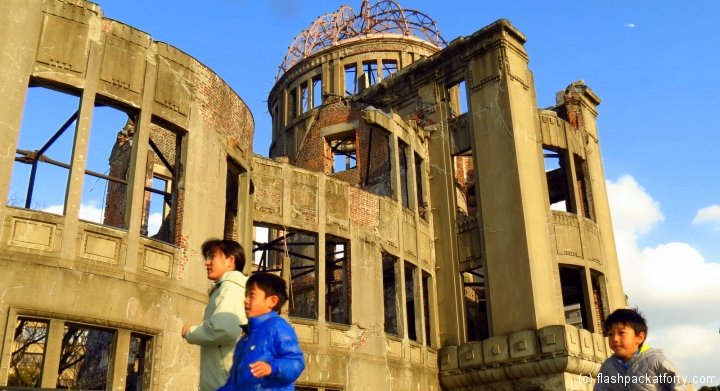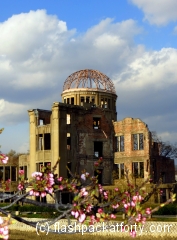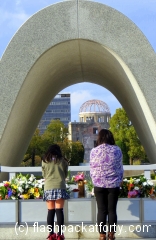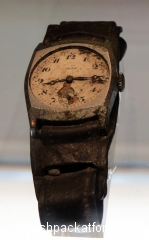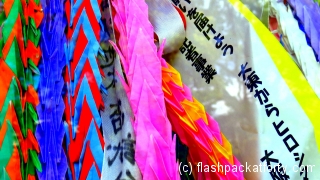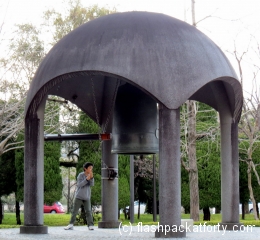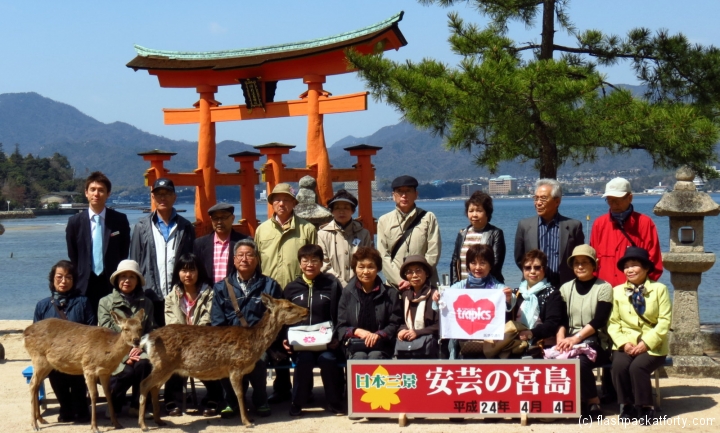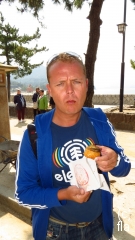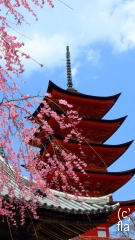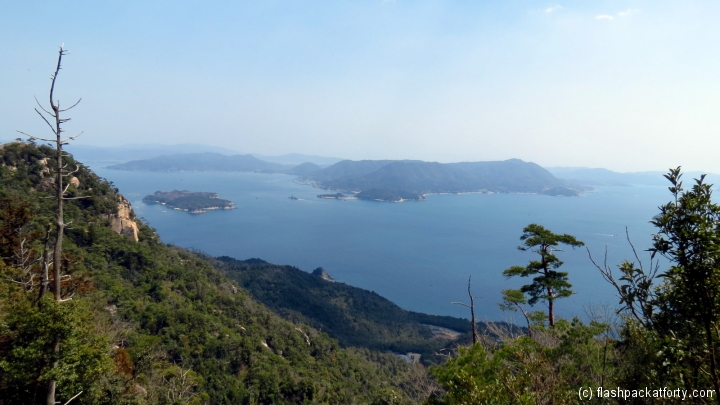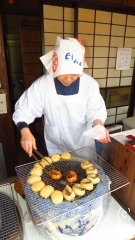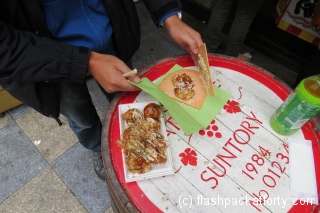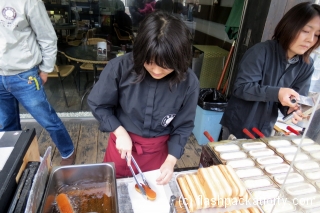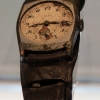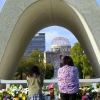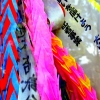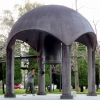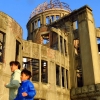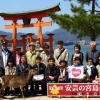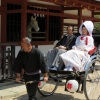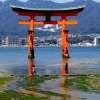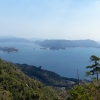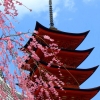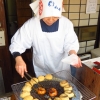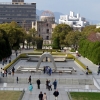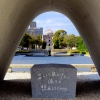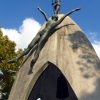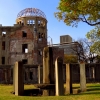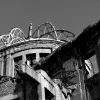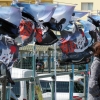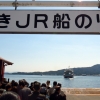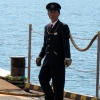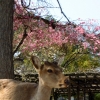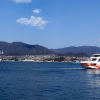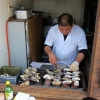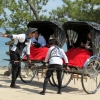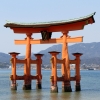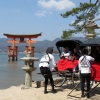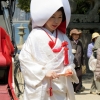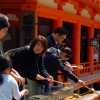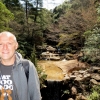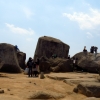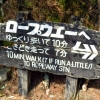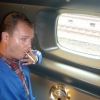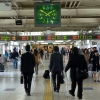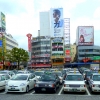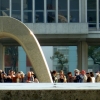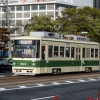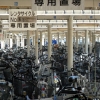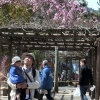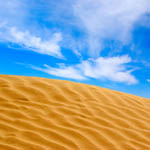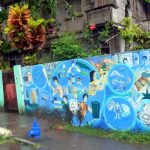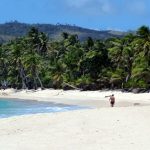Hiroshima and Miyajima
Traveling from Osaka to Hiroshima
Our first journey from Osaka took us to Hiroshima, and gave us our inaugural ride on the bullet train. A mere hour and half after stepping on at Shin-Osaka we were in Hiroshima, 306km away. We had hurtled there at over 180kmph through tunnels and along the Shinkansen high speed track.
We didn’t realise at the time, but the nice train guard had given us a free upgrade to a Green Car when we made our reservation, this is a first class carriage. We were here to sample the moving peace memorial and park and also visit a nearby island with a UNESCO listed shrine.
I had always wanted to visit Hiroshima since first seeing the iconic images of the Peace dome in my youth. I was a fully paid up marching member of CND. I couldn’t see the point in British nuclear weapons then and the intervening years have not changed my opinion on that, or my desire to see a nuclear weapons free world. This place was therefore going to be a little bit of a pilgrimage for me.
As we arrived just after lunch we decided to visit the Hiroshima Peace Park for the afternoon. It was a ten minute walk or a few minutes tram ride from the hotel. We decided to walk in what was a rather blustery day as we dodged toppled bikes and mopeds (we learned later that Tokyo had been lashed by the strongest winds for decades).
Hiroshima: August 6th 1945, 8.15am
We entered the park through the main entrance and decided to visit the Peace Memorial Museum first. We are glad we did it this way round as it informed us in detail about the events which led up to the formation of the park and the work that the successive Mayors and people of Hiroshima have done in pursuit of their goal of ridding the world of nuclear weapons.
Every time a nuclear test is carried out anywhere in the world, the incumbent Mayor of Hiroshima writes a letter of protest to the Head of State of the country where the tests have been carried out. Facsimiles of every letter are displayed in the museum. Some may see this as a futile gesture, but I found the stoicism uplifting.
The exhibition gives details about events in history leading up to the Japan involvement in the Pacific War, the wartime creation of the bomb and the choice of Hiroshima and Nagasaki as targets by the American and allied leaders. The museum rightly chooses not to leave you with the simple historical facts. It also provides you with a truthful and disturbing glimpse of the impact and long term effects of the bomb. This is graphic and at times very hard to stomach; but this is the intention to inform honestly and tell the truth about what happened.
One of the most poignant pieces in the museum was that of a charred watch of one of the victims that stopped at exactly the time the bomb exploded at 8.15am on 6 August 1945. It also tells the moving story of a little girl, Sadako Sasaki, who died of leukemia ten years after the atomic bombing. She believed that if she could fold and create a thousand paper cranes she would be cured. Her memory and the story has been symbolised by the children’s peace movement. The park is adorned with thousands upon thousands of cranes brought by children from around the world as a symbol of peace.
The museum will move you (sometimes to tears) and you will spend most of the time in the building in an eerie silence, the story being told is powerful, moving and sad.
We managed to gather ourselves for a wander around the park, viewing the different peace memorials located here. Finally, we made our way to the Peace Memorial Dome as the sun was setting. It was strange to see it in real life. This building which, amid the flattening of the majority of the of the city in 1945 stood upright, scarred and beaten, but defiantly still standing. It is fitting that it remains in place in much the same state as it was after the bomb, reminding us of the devastation and futility that this kind of cowardly warfare can bring.
We were travelling on the tram on the way home and opposite was a old Japanese lady who must have been about 80 years old. I could not help wondering whether she had witnessed the horrific events of 1945, she would have been a teenager then. I had a lump in my throat as I watched her look out of the window observing the world go by wondering what painful memories she had locked, hopefully buried deep, in her mind.
From Hiroshima to Miyajima Island
The next day we visited the Island of Miyajima, which is about a forty minute train and ten minute ferry ride from Hiroshima (valid with your Japan Rail pass).
The Island is best known for its Itsukushima Shrine that boasts a beautiful vermilion Torri gate which sits out in the bay and is partially submerged at high tide, so appears to be floating.
To get here you first have to dodge your way through the many ‘wild’ deer that roam the streets looking for tasty morsels of food (stolen or given, they don’t care) from the thousands of tourists that pass through here each day.
On the way we were lucky enough to see a wedding taking place and managed to stalk the bride and groom long enough to capture some images of her beautiful dress and fancy mode of bridal transport in the form of a rickshaw.
The gate and the rest of the shrine are impressive especially when you think that they have been in place since the 16th century, hence its UNESCO listing.
Next was a trip up to the summit of Mount Misen. We were ready for a little hike after researching this must do trip on Miyajima, but be prepared; its a lot harder and steeper than you think.
You have about a ten to fifteen minute gentle incline walk from the town to get to the first cable car (or ropeway as they like to call them in Japan). After you have ridden the two cable cars (you swap at a station near the top) you are then faced with a very steep thirty minute hike to reach the summit of the mount.
For this herculean effort on our part we were rewarded with 360 degree views of the bay and other small islands surrounding Miyimjimo. It is worth it but we were glad we packed water and had a few rest stops along the way.
It was only fair then that on the way back we treated ourselves to some of the local delicacies before we left the island and headed back to Osaka.
They first morsel consisted of momiji manju. These are sweet buns shaped like maple leaves (Miyajima is renowned for the autumnal colours of its maples). The traditional variety have a red bean paste filling.
Gladly they have got all creative and chocolate, custard and even cream cheese are also available. We tried a few to see which we liked best (chocolate for me!).
You can also not lave the island without trying the local oysters. You can have them in the traditional fashion right out of the shell or in a hot variety on top of a deep fried rice fried ball smothered in a slighty sticky spicy sauce, they were lovely as John’s face will attest.
Street Food in Japan
The food here is proving something of a challenge. Not that we cant find anything we like, but it is all so tasty. It is also available at every corner you turn, from small stalls selling their specialities, to restaurants serving a full menu. We cannot stop eating, admittedly most are small snacks, but we fear they are adding up and enlarging our recently reduced waistlines.
At home we tend to think of Japanese food as Sushi or Sashimi dishes which we’ve enjoyed here. We’ve also tasted the two local speciality dishes of the Osaka area. Okinomiyaki which is a cabbage, egg and noodle based dish which is spiced and served with bacon and seafood and usually grilled in front of you on a hotplate at your table. When its done you choose your sauce to smother on top and finish it off with some yummy Japanese Mayonaisse.
Another street food favourite here is Takoyaki, this is an octopus mix fried inside a little batter ball and then adorned with a variety of spices and mayonnaise to your taste. They are usually sold in little trays of six or eight and cost about 300 Yen (£2.50), great snack food if you are feeling peckish.
There is also a lovely doughnut based fried sweet which you can also pick up on the street it is sugared bean curd fried inside a doughnut batter and again is easily and cheaply available so had to be eaten.
Often we are not sure what we are eating or the correct protocols in the little restaurants, but we have got by with the wonderful help and patience of the Japanese. So far we have not ordered anything we don’t like, although a portion of pak choi we picked up in a restaurant was laced with wasabi and was a little spicy.
Other things we have tried are green tea ice cream in Kyoto, and Mochi which is a rice flour which has been kneaded and beaten to within an inch of its life so that it has a beautiful creamy texture. It is served with sweetened bean curd and then dusted with some spices. I am sure these particular treats are an acquired taste but I have yet to acquire it. I kind of enjoyed them, the texture at least, but they left me feeling a bit full and bloated.

